In this article, we will read about Universe and Solar system Planets information. This is the first article of your Geomorphology course for Geography Optional UPSC aspirants.
UNIVERSE
- Everything that exists, from the Galactic Mega clusters to the tiniest subatomic particles, comprises the Universe.
- As for the age of the Universe, scientists agree that it is about 13.79 billion years old as 2015.
- The universe comprises of a number of galaxies.
- Optical and radio telescope studies indicate the existence of about 100 billion galaxies in the visible universe.
- The Big Bang Theory is most acceptable for the origin of the Universe.
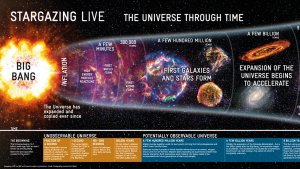
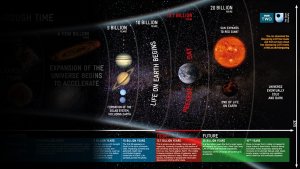
GALAXY
- Galaxy is a collection of millions or billions of stars and planets that are held together by gravitational pull.
- Milky Way is one such galaxy. The earth lies in this galaxy. It is called Milky Way because it looks like a river of milky light flowing from one corner to another of the sky.
- It is spiral in shape.
- We call it Akash Ganga.
- The nearest galaxy to Milky Way is Andromeda.
- Andromeda is a spiral galaxy and approximately 2.5 million light-years from the earth.
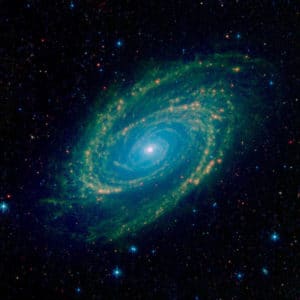
STARS
- Luminous heavenly bodies which have their own light and other radiant energy are called a star.
- They are made of extremely hot burning gases.
- Star reflects Looks – Red with low temperature, Yellow with higher and blue with very high temperature.
Star (Birth to Death)
- Star starts its life as clouds of dust and gas known as Nebula.
- The gaseous matter of Nebula further contracts to make dense region named ProtoStar.
- The ProtoStar further condenses to a critical stage of mass where nuclear fusion begins and star finally comes into existence.
- When all the hydrogens of a star are used up then its helium begins fusing into carbon. At a stage helium’s fusion and energy production inside the star stops. As a result, stars core contracts under its own weight to a very high density to make a white Dwarf star.
- A white Dwarf star becomes dark balls of matter on cooling to make Black Dwarf Star.
- The mass of white Dwarf Star is less than 1.44 times the mass of the Sun named as Chandrasekhar Limiting Mass.
- White Dwarf Star is a dead star because of the end of fusion reaction and energy production.
- It shines by radiating its stored heat.
- The giant star expands into Red Supergiant after consuming its fuel (H & He). At a stage, it explodes as Supernova or changes into Neutron or Black Holes.
- The nearest star to the Earth is the Sun followed by Proxima and Alpha Centauri and radiant energy. (4.35 Light years)
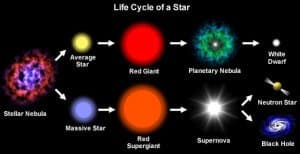
Constellations
- A Constellation is a group of stars that makes an imaginary shape in the sky at night.
- It helps in navigation of sea vessel during the night as they are seen in a fixed direction at a particular period of time in a year.
- Orian, Big Dipper, Great Bear, Cassiopeia are some examples of constellations.
- Orion or Mriga can be seen in the late evening during winter; Cassiopeia in the Northern Sky is seen during winter.
- Great Bear consists of Ursa Minor (Laghu Saptarishi) and Ursa Major (Vrihat Saptarishi) and can be seen in the early night during summer.
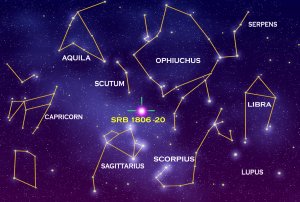
Sun
- It is a star made up of extremely hot gases, particularly by hydrogen (70%), Helium (26.5%), and others (3.5%) gases.
- It is 109 times bigger than the earth and weighs 2 × 1027 tonnes, and accounts for 99.83% of the mass of the solar system.
- It is 150 million km away from earth. The sunlight takes 8 minutes to reach the earth’s surface.
- It has immense gravitational pull which keeps the planets fixed in their orbit, revolving around the sun.
- It continuously gives off energy in the form of visible light, infra-red, ultraviolet, X- rays, gamma rays, radio waves, and plasma gas.
- The sudden flash of brightness observed near the sun’s surface which is a collection of magnetic energy including electrons, protons, and nuclei are called solar flares. They are concise particles and are harmful for satellite communication.
- The core of the sun consists of hydrogen atoms which fuse together due to compression and creates helium. This is called nuclear fusion.
- Nuclear fusion produces a huge amount of energy. It is radiated outward to the surface, atmosphere, and beyond.
- The convection zone is the next to the core of the sun. Here the temperature drops to 2-million-degree C.
- The photosphere’s temperature is 6,000°C.
- The atmosphere of the sun consists of the chromosphere and corona.
- Corona is seen in a form of spectral lines emitted by iron, calcium, and Nickle ions. The ionization of these elements increases the temperature of the corona.
- The solar flare (wind) is a stream of charged particles released from the upper atmosphere of the sun.
- These changed particles when get trapped by the earth’s magnetic field while entering the upper atmosphere of the earth result in the auroral (light) display.
- These auroral display in the northern hemisphere is called as Aurora Borealis (the Northern light) and when occurs in the southern hemisphere is called as Aurora Australis (the Southern lights).
- Sun-spots are dark appearing areas present in the photosphere from where solar flares originate. They are relatively a region cooler than its surrounding. It appears and disappears after every 11 years. This period is called the Sunspot Cycle.
- The cycle is marked by the increase and decrease of sunspots — visible as dark blemishes on the sun’s surface, or photosphere. The greatest number of Sunspots in any given solar cycle is designed as “solar maximum” and the lowest number is the “solar minimum“.

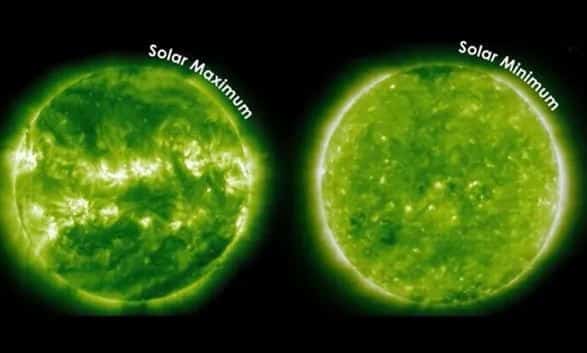
- The solar wind is a stream of charged particles released from the upper atmosphere of the Sun, called the corona. This plasma mostly consists of electrons, protons, and alpha particles with kinetic energy between 0.5 and 10 keV.
- A solar storm is a disturbance on the Sun, which can emanate outward across the heliosphere, affecting the entire Solar System, including Earth and its magnetosphere, and is the cause of space weather in the short-term with long-term patterns comprising space climate.
- A geomagnetic storm is a temporary disturbance of the Earth’s magnetosphere caused by a solar wind shock wave and/or cloud of a magnetic field that interacts with the Earth’s magnetic field.
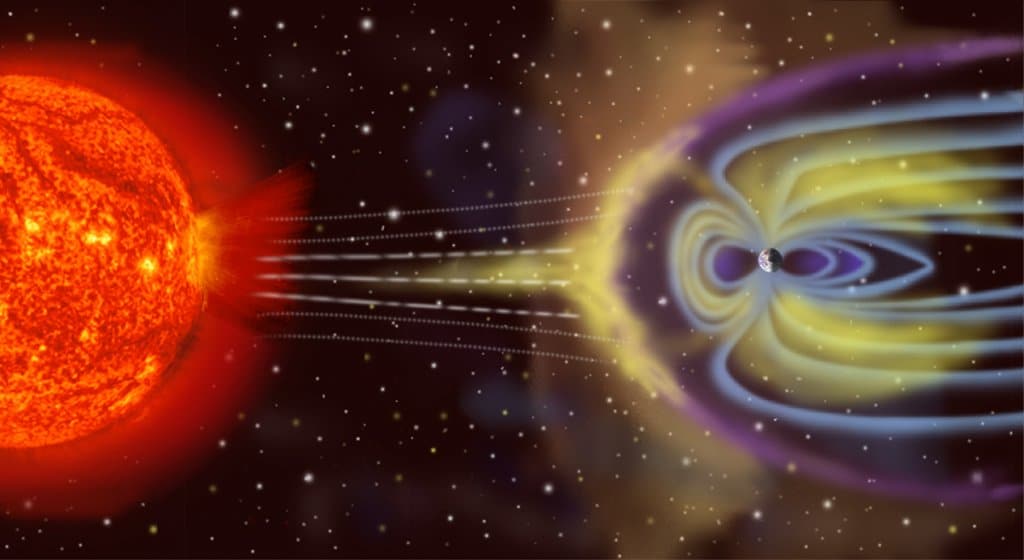
PLANETS
- Planets mean wanderers. There are eight planets in our solar system (Mercury, Venus, Earth, Mars, Jupiter, Saturn, Uranus, and Neptune).
- All these planets move around the sun in a fixed orbit. Which is elongated in shape (elliptical).
- International Astronomical Union (IAU) recognized five dwarf planets such as Ceres, Pluto, Haumea, Makemake, and Sedan.
- The planets are grouped into two:
Terrestrial planets: These are dense rocky bodies and are called as earth-like planets. Mercury, Venus, Earth, and Mars are included in it. They are also called as inner planets.
Jovian Planets: The outer planets which are gigantic in size and are gaseous in composition with large satellite are called Jovian planets. These have similar features to that of Jupiter, thus called as Jupiter like planets.
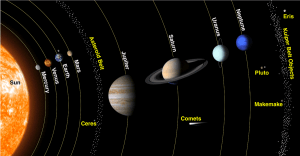
Pluto, the Dwarf Planet
- Pluto was known as the smallest planet in the solar system and the ninth planet from the sun.
- Today Pluto is called a “dwarf planet”.
- On average, Pluto is more than 3.6 billion miles away from the sun.
- Pluto is in a region called the Kuiper Belt. One day on Pluto is about 61/2 days on Earth.
- It has five moons. Its largest moon is named Charon.
- Pluto’s four other moons are named Kerberos, Styx, Nix, and Hydra.
The Kuiper Belt (also known as the Edgeworth–Kuiper belt) is a region of the Solar System that exists beyond the eight major planets, extending from the orbit of Neptune (at 30 AU) to approximately 50 AU from the Sun. It is similar to the asteroid belt, in that it contains many small bodies, all remnants from the Solar System’s formation. But unlike the Asteroid Belt, it is much larger – 20 times as wide and 20 to 200 times as massive.
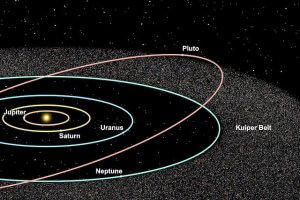
Mercury
- Mercury is the smallest planet in our solar system – only slightly larger than the Earth’s moon.
- It is the closest planet to the sun at a distance of about 58 million km (36 million miles) or 0.39 AU.
- One day on Mercury takes 59 Earth days.
- Mercury is a rocky planet, also known as a terrestrial planet.
- Mercury’s thin atmosphere, or exosphere, is composed mostly of oxygen (O2), sodium (Na), hydrogen (H2), helium (He), and potassium (K). Atoms that are blasted off the surface by the solar wind and micrometeoroid impacts create Mercury’s exosphere.
- Only two missions have visited this rocky planet: Mariner 10 in 1974-5 and MESSENGER, which flew past
- Mercury three times before going into orbit around Mercury in 2011.
- Daytime Temperatures can reach 430° Celsius (800° Fahrenheit) and drop to -180° Celsius (-290° Fahrenheit) at night.
Venus
- Venus is only a little smaller than the Earth.
- Venus is the second closest planet to the sun at a distance of about 108 million km (67 million miles) or 0.72 AU.
- One day on Venus lasts as long as 243 Earth days (the time it takes for Venus to rotate or spin once).
- Venus is a rocky planet, also known as a terrestrial planet. Venus’ solid surface is a created and volcanic landscape.
- Venus’ thick and toxic atmosphere is made up mostly of carbon dioxide (CO2) and nitrogen (N2), with clouds of sulfuric acid (H2SO4) droplets.
- More than 40 spacecraft have explored Venus. The Magellan mission in the early 1990s mapped 98% of the planet’s surface.
- The planet’s extremely high temperatures of almost 480° Celsius (900° Fahrenheit) made it seem an unlikely place for life as we know it.
- Venus spins backward (retrograde rotation) when compared to the other planets. This means that the sun rises in the west and sets in the east on Venus.
Earth
- Earth is the third planet from the sun at a distance of about 150 million km (93 million miles). That’s one Astronomical Unit (AU).
- A day on Earth is 24 hours (the time it takes the Earth to rotate or spin once).
- Earth’s atmosphere is 78% nitrogen (N2), 21% oxygen (O2) and 1% other ingredients – the perfect balance for living beings to breathe and live. Many planets in our solar system have atmospheres, but only Earth is breathable.
- Earth has one moon. Another name for a moon is a natural satellite.
- Earth is the perfect place for life as we know it.
- Our atmosphere protects us from incoming meteoroids, most of which break up in our atmosphere before they can strike the surface as meteorites.
Mars
- Mars is the fourth planet from the sun at a distance of about 228 million km (142 million miles) or 1.52 AU.
- One day on Mars takes just a little over 24 hours (the time it takes for Mars to rotate or spin once).
- Mars is a rocky planet, also known as a terrestrial planet. Mars’ solid surface has been altered by volcanoes, impacts, crustal movement and movement and atmospheric effects such as dust storms.
- Mars has a thin atmosphere made up mostly of carbon dioxide (CO2), nitrogen (N2) and argon (Ar).
- Mars has two moons named Phobos and Deimos.
- Several missions have visited this planet, from flybys and orbiters to rovers on the surface of the Red Planet. The first true Mars mission success was Mariner 4 in 1965. At this time in the planet’s history, Mars’ surface cannot support life as we know it. Current missions exploring Mars on the surface and from orbit are determining Mars’ past and future potential for life.
- Mars is known as the Red Planet because iron minerals in the Martian soil oxidize, or rust, causing the soil and the dusty atmosphere to look red.
Jezero Crater
Jezero Crater is a 45 km wide crater located north of the Martian equator. It is located on the edge of Isidis Planitia, a flat plain. While the crater itself was created by the impact of meteorites, the flat plain was formed by the impact of an ancient asteroid in an event called Isidis event. The crater shows evidences of an ancient river system and it even has remnants of a delta. The Jezero Crater is the landing site of NASA’s Perseverance mission.
Jupiter
- About 1,300 Earths could fit inside Jupiter.
- Jupiter is the fifth planet from the sun at a distance of about 778 million km (484 million miles) or 5.2 Astronomical Units (AU). Earth is one AU from the sun.
- One day on Jupiter takes about 10 hours (the time it takes for Jupiter to rotate or spin once).
- Jupiter is a gas-giant planet and therefore does not have a solid surface. Jupiter may have a solid, inner core about the size of the Earth.
- Jupiter’s atmosphere is made up mostly of hydrogen (H2) and helium (He).
- Jupiter has 50 known moons, with an additional 17 moons awaiting confirmation of their discovery, that is a total of 67 moons.
- Jupiter has a faint ring system that was discovered in 1979 by the Voyager-1 mission. All four giant planets in our solar system have ring systems.
- Many missions have visited Jupiter and its system of moons. The Juno mission will arrive at Jupiter in 2016.
- Jupiter cannot support life as we know it. However, some of Jupiter’s moons have oceans underneath their crusts that might support life.
Saturn
- Saturn is the sixth planet from the sun at a distance of about 1.4 billion km (886 million miles) or 9.5 AU.
- One day on Saturn takes 10.7 hours (the time it takes for Saturn to rotate or spin once).
- Saturn is a gas-giant planet and therefore does not have a solid surface. Saturn’s atmosphere is made up mostly of hydrogen (H2) and helium (He).
- Saturn has 53 known moons with an additional nine moons awaiting confirmation of their discovery, that is a total of 62 moons.
- Saturn has the most spectacular ring system, which is made up of seven rings with several gaps and divisions between them.
- Only a few missions have visited Saturn: Pioneer 11, Voyager 1 and 2 and Cassini-Huygens. Since 2004, Cassini has been exploring Saturn, its moons and rings.
- Fact: When Galileo Galilei was observing the planet Saturn in the 1600s, he noticed strange objects on each side of the planet and drew in his notes a triple-bodied planet system and later a planet with arms or handles. These “handles” were, in fact, the rings of Saturn.
Uranus
- Uranus is the seventh planet from the sun at a distance of about 2.9 billion km (1.8 billion miles) or 19.19 AU.
- One day on Uranus takes about 17 hours (the time it takes for Uranus to rotate or spin once).
- Uranus is an ice giant. Most (80 % or more) of the planet’s mass is made up of a hot dense fluid of “icy” materials – water (H2O), methane (CH4), and ammonia (NH3) – above a small rocky core.
- Uranus has an atmosphere which is mostly made up of hydrogen (H2) and helium (He), with a small amount of methane (CH4).
- Uranus has 27 moons. Uranus’ moons are named after characters from the works of William Shakespeare and Alexander Pope.
- Uranus has 13 known rings. The inner rings are narrow and dark and the outer rings are brightly colored.
- Voyager 2 is the only spacecraft to have visited Uranus.
- Uranus cannot support life as we know it.
- Unlike any of the other planets, Uranus rotates on its side, which means it spins horizontally.
Neptune
- Neptune is the eighth and farthest planet from the sun at a distance of about 4.5 billion km (2.8 billion miles) or 30.07 AU.
- One day on Neptune takes about 16 hours (the time it takes for Neptune to rotate or spin once).
- Neptune is a sister ice giant to Uranus.
- Neptune’s atmosphere is made up mostly of hydrogen (H2), helium (He) and methane (CH4).
- Neptune has 13 moons. Neptune’s moons are named after various sea gods and nymphs in Greek mythology.
- Neptune has six rings.
- Voyager 2 is the only spacecraft to have visited Neptune.
- Neptune cannot support life as we know it.
Moon
- The moon is Earth’s natural satellite and orbits the Earth at a distance of about 384 thousand km (239 thousand miles) or 0.00257 AU.
- The moon makes a complete orbit around Earth in about 27.32 Earth days (~around 28 days) and rotates or spins at that same rate, or in that same amount of time. This causes the moon to keep the same side or face towards Earth during the course of its orbit.
- The moon is a rocky, solid-surface body, with much of its surface cratered and pitted from impacts.
- The moon has a very thin and tenuous (weak) atmosphere, called an exosphere.
- More than 100 spacecraft have been launched to explore the moon. It is the only celestial body beyond Earth that has been visited by human beings.
- Twelve human beings have walked on the surface of the moon.
Asteroids
- Asteroids are minor planets especially those of the inner solar system.
- Asteroids orbit our sun in a region of space between the orbits of Mars and Jupiter known as the Asteroid Belt.
- Asteroids are solid, rocky and irregular bodies.
- Asteroids do not have atmospheres.
- More than 150 asteroids are known to have a small companion moon (some have two moons). The first discovery of an asteroid-moon system was of asteroid Ida and its moon Dactyl in 1993.
- Asteroids do not have rings.
- NASA space missions have flown by and observed asteroids. The Dawn mission is the first mission to orbit (2011) a main-belt asteroid (Vesta).
- Asteroids cannot support life.
- Ceres, the first and largest asteroid to be discovered (1801 by Giuseppe Piazzi), encompasses over one-third of the estimated total mass of all the asteroids in the asteroid belt.
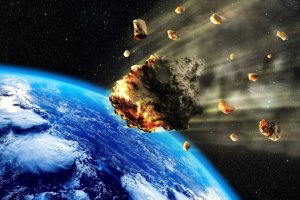
Meteorites
- Meteorites may vary in size from tiny grains to large boulders. One of the largest meteorites found on Earth is the Hoba meteorite from southwest Africa, which weighs roughly 54,000 kg (119,000 pounds).
- Meteor showers are usually named after a star or constellation which is close to the radiant. Meteors and meteorites begin as meteoroids, which are little chunks of rock and debris in space.
- Most meteorites are either iron, stony or stony-iron.
- Leonid MAC (an airborne mission that took flight during the years 1998 – 2002) studied the interaction of meteoroids with the Earth’s atmosphere.
- Meteoroids, meteors, and meteorites can not support life. However, they may have provided the Earth with a source of amino acids: the building blocks of life.
- Meteoroids become meteors or shooting stars when they interact with a planet’s atmosphere and cause a streak of light in the sky. Debris that makes it to the surface of a planet from meteoroids are called meteorites.
- Meteorites may look very much like Earth rocks, or they may have a burned appearance. Some may have depression (thumbprint-like), roughened or smooth exteriors.
- Many of the meteor showers are associated with comets.
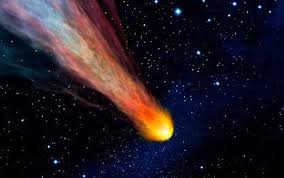
Comets
- Comets are cosmic snowballs of frozen gases, rock, and dust.
- A comet warms up as it comes near the sun and develops an atmosphere or coma. The coma maybe hundreds of thousands of kilometers in diameter.
- Comets do not have moons.
- Comets do not have rings.
- Several missions have visited, impacted and even collected samples from comets
- When comets come around the sun, they leave a dusty trail. Every year the Earth passes through the comet tails, which allows the debris to enter our atmosphere where it burns up and creates fery and colorful streaks (meteors) in the sky.
- Comets may not be able to support life themselves, but they may have brought water and organic compounds, i.e., the building blocks of life — through collisions with the Earth and other bodies in our solar system.
- Comet Halley -It is a short period comet visible from Earth every 75-76 years. Halley last appeared in the inner part of the solar system in 1986 and will next appear in mid – 2061.
Kármán Line
The Kármán line is the altitude where space begins. It is 100 km (about 62 miles) high. The Kármán line is an attempt to define a boundary between Earth’s atmosphere and outer space. This is important for legal and regulatory measures; aircraft and spacecraft fall under different jurisdictions and are subject to different treaties.
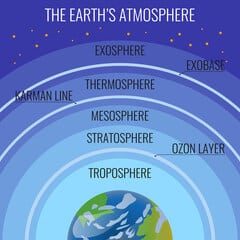
References: NCERT, G C Leong, Wikipedia

Thanks
Most Welcome
Great content
One of the best site to completely rely upon for preparing govt exams. Thanks to lotus arise team to working passionately for students.
Thanks, Suhani for your kind words.
Sir it is great initiative for us .
I am new ,is it enough for geography optional please tell sir
Thank you
Most Welcome
Nice
Great work and there are areas of improvement…few errors are there
Okay, thanks for the feedback. I will update the content.
thanku
Really Good Content:- It is really Helpful
Sir can I access the all pdf of geography optional if i choose premium
Yeah Sure!
Best description for making a notes thanks
Thank you so much sir
Hlo I have small doubt for , purchase physical geography pdf
Contact on Whatsapp!
Thanx really helpful
Good content👍